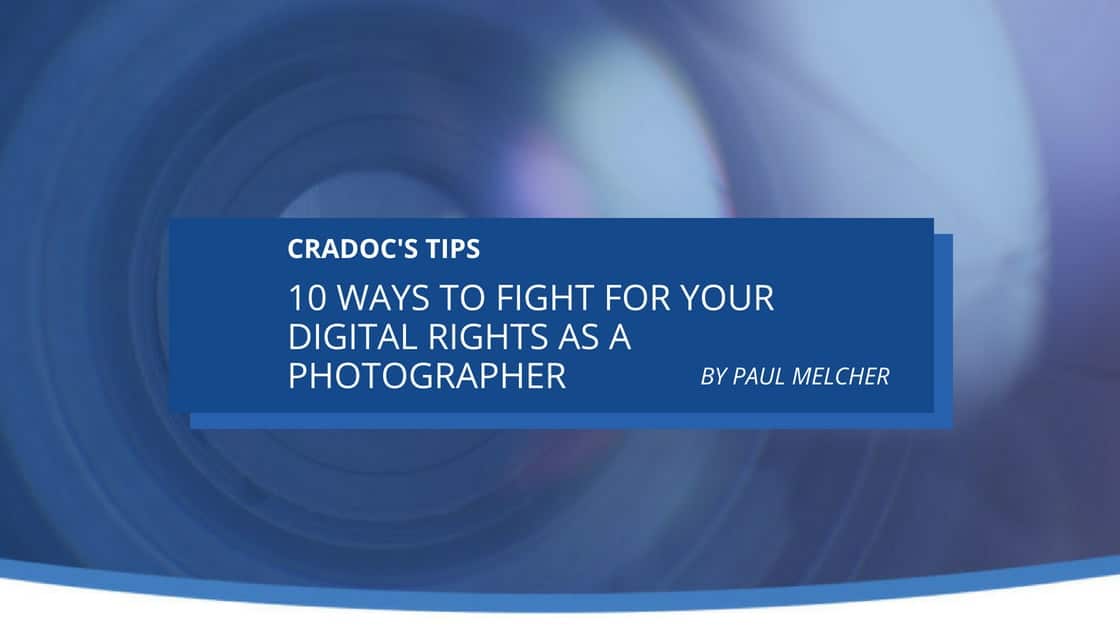By Paul Melcher
The fight for your digital rights would seem to be an uphill battle these days. Let’s face it; the rights of photographers have been badly battered.
First came Google, when it won the case to publish images in its search results without paying anything. Then came National Geographic and others, republishing entire issues on CD-ROM without paying additional fees. Even today, the magazine industry poor-mouths its way to paying pennies for images on Web sites that now have bigger circulations than the corresponding print editions.
And yet, many in the photo industry still view the Web as their savior. The question is, How so?
An image posted on the home page of a site that receives one million hits per week is not licensed at the same price as an image on the cover of a weekly magazine that has one million readers. Why is that?
What makes publishers believe that images online are worth less than those in print? What makes photographers and photo agencies agree?
Most of the discourse is about how a magazine’s online edition generates far less revenue than its print edition. Since when has that been the concern of photographers and agencies? Is this now one of our responsibilities — to guarantee revenue on top of licensing images?
It shouldn’t be.
Here are 10 ways you — and all of us in the industry — can fight for your digital rights.
1. Stop treating “digital rights” as an add-on to a license.
Maybe we should make “print rights” as an additional right. We should treat Web usage as a full-blown license of its own.
2. Stop licensing images online as “one week on home page” or “one day inside, 1/4 page.”
A Web site is not a magazine; it doesn’t work that way. We should also stop making a distinction between commercial and editorial usage. Most editorial sites have a hundred times more traffic than corporate sites. We should treat the Web as an entity. It has measurable traffic — much more so than a magazine. Charge a license based on traffic; that is how sites charge advertisers, isn’t it?
3. Don’t buy into the poverty talk.
Many editorial sites today have a budget bigger than their print siblings. As publications close their print editions for online only, they shift their budgets. Some with the biggest traffic charge $400,000 for a one-day banner ad.
4. Don’t buy the “it’s good publicity” argument.
How many images have you ever licensed because one of your images appeared online? Would you offer your images for pennies to a print magazine because it’s “good publicity”?
5. Stop believing that because the image is of a smaller size and only 72 dpi, it has less value.
That is like saying that if an image is used in B/W, although it was shot in color, it has less value. Where does that come from? The value of an image has nothing to do with the numbers of pixels it has — nothing. Does a Cartier-Bresson or Leibovitz image lose value with fewer pixels?
6. Stop waiting for others to act.
Stop expecting someone else to show you the way. Google is taking your rights away, yet you turn a blind eye. Call that association to which you pay a hefty membership fee, and tell them to act. Tell your agency to stop giving away your rights and your images. And if they don’t, leave them. This is your problem, now. Not someone else’s in the future. It’s not going to go away; it’s only going to get worse.
7. Focus less on what to shoot next — and more on licensing what you already have.
Unless we start dealing with the issues at hand, those magical pictures you plan to shoot in the future will only generate a fraction of what your existing images can.
8. Stop being beggars.
Your images are needed. In fact, they are the core value of many publications and Web sites. These publishers are not doing you a favor by using your work; you are bringing them the value they need in order to run their business. What you do is unique. Trust me, if they could do it themselves and shut you out, they would. But they can’t.
9. Stop being technophobes.
It’s not cute anymore. All the information is at your fingertips. Read, learn. Saying you don’t understand is no excuse anymore. You shoot digital, don’t you? So stop the crap about how you do not understand RSS feeds or HTML, or anything Web-related. No one buys it — and if they do, it’s only so they can squeeze more out of you.
10. Stop being afraid.
Stop being afraid of losing clients, afraid of tomorrow, afraid of big corporations, afraid of your own decisions. The images you shoot or that you license have the value you give them. Bargain if necessary, until you have no breath left. And leave the table if you have to.
Your images are like your children. Don’t let them be mistreated.
Paul Melcher brings more than 17 years of experience in technology breakthrough and leadership roles for world-renowned photography agencies and was named by American Photo as one of the “50 most influential individuals in American photography.
Mr. Melcher is currently the C.K.O. of Zymmetrical.com, the first midstock visual art marketplace, and strategist for Adbuynet, an on-line, self service, video advertising agency. He also a consultant for a variety of high tech software service companies that are involved in the image licensing world. For more information about Paul Melcher visit his blog at blog.melchersystem.com
Check out our FREE Demos!


